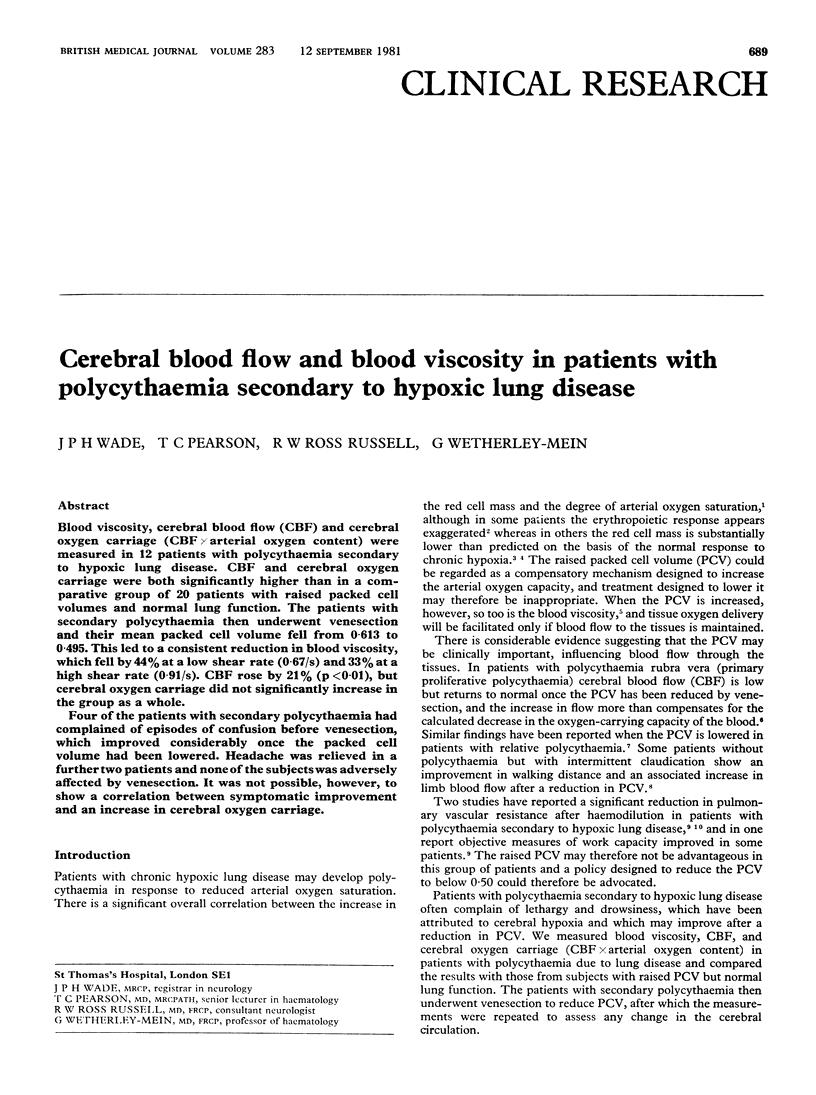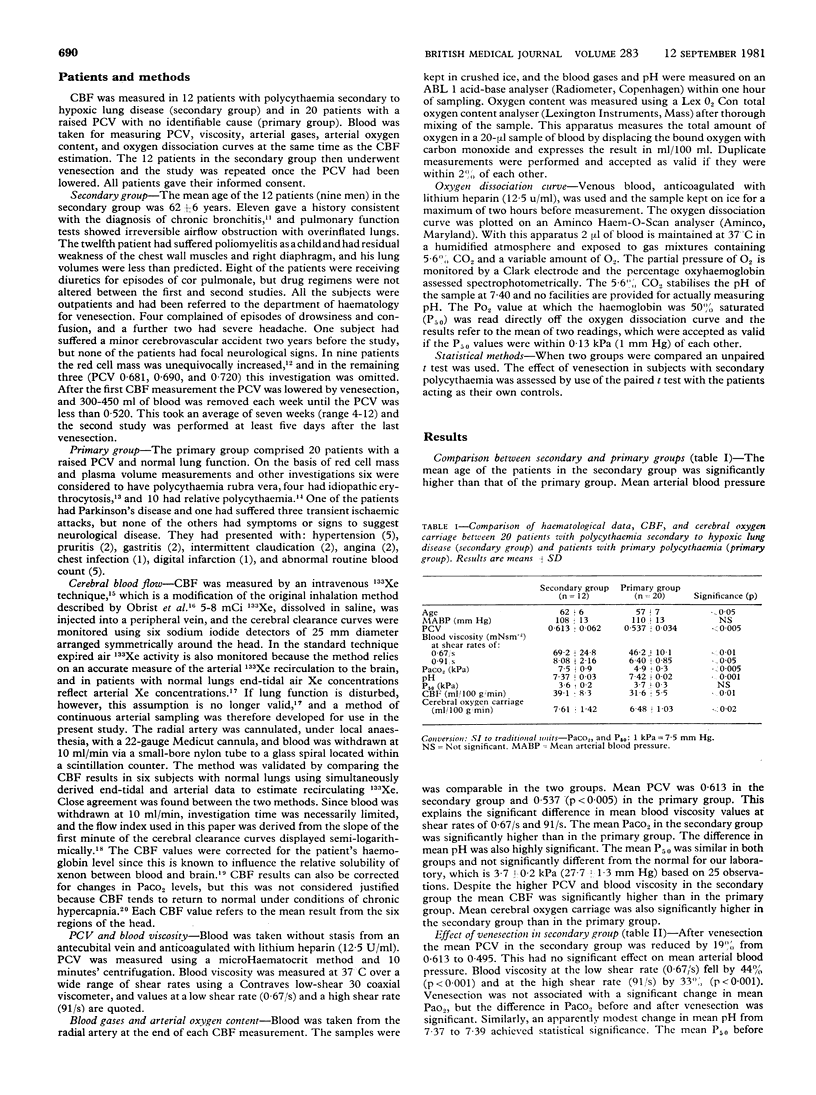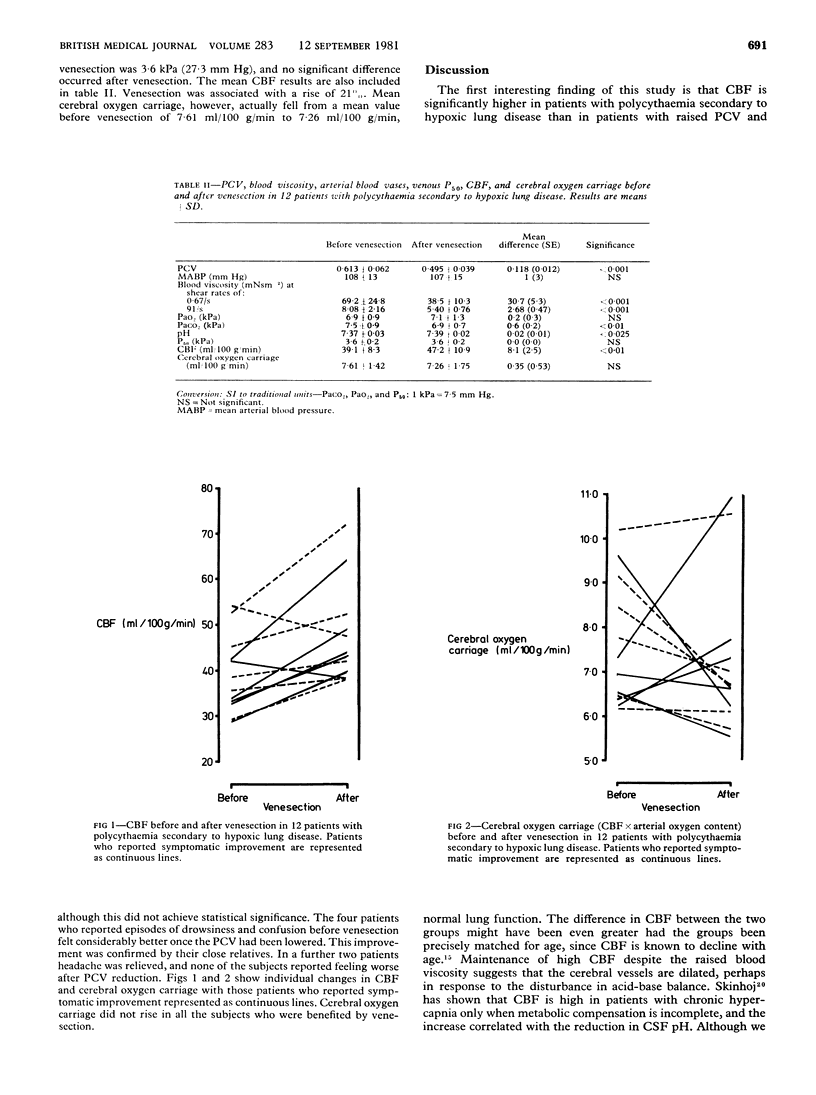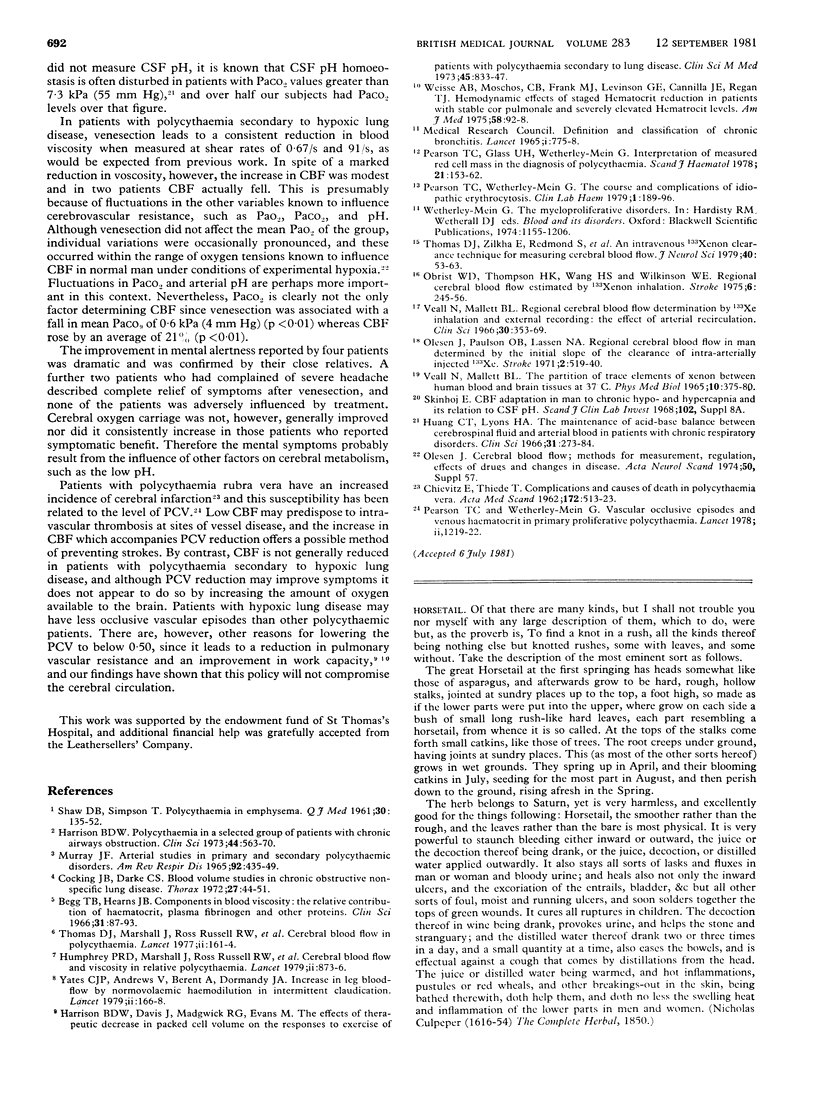Abstract
Blood viscosity, cerebral blood flow (CBF) and cerebral oxygen carriage (CBF X arterial oxygen content) were measured in 12 patients with polycythaemia secondary to hypoxic lung disease. CBF and cerebral oxygen carriage were both significantly higher than in a comparative group of 20 patients with raised packed cell volumes and normal lung function. The patients with secondary polycythaemia then underwent venesection and their mean packed cell volume fell from 0.613 to 0.495. This led to a consistent reduction in blood viscosity, which fell by 44% at a low shear rate (0.67/s) and 33% at a high shear rate (0.91/s). CBF rose by 21% (p less than 0.01), but cerebral oxygen carriage did not significantly increase in the group as a whole. Four of the patients with secondary polycythaemia had complained of episodes of confusion before venesection, which improved considerably once the packed cell volume had been lowered. Headache was relieved in a further two patients and none of the subjects was adversely affected by venesection. It was not possible, however, to show a correlation between symptomatic improvement and an increase in cerebral oxygen carriage.
Full text
PDF



Selected References
These references are in PubMed. This may not be the complete list of references from this article.
- Begg T. B., Hearns J. B. Components in blood viscosity. The relative contribution of haematocrit, plasma fibrinogen and other proteins. Clin Sci. 1966 Aug;31(1):87–93. [PubMed] [Google Scholar]
- CHIEVITZ E., THIEDE T. Complications and causes of death in polycythaemia vera. Acta Med Scand. 1962 Nov;172:513–523. doi: 10.1111/j.0954-6820.1962.tb07186.x. [DOI] [PubMed] [Google Scholar]
- Cocking J. B., Darke C. S. Blood volume studies in chronic obstructive non-specific lung disease. Thorax. 1972 Jan;27(1):44–51. doi: 10.1136/thx.27.1.44. [DOI] [PMC free article] [PubMed] [Google Scholar]
- Harrison B. D., Davis J., Madgwick R. G., Evans M. The effects of therapeutic decrease in packed cell volume on the responses to exercise of patients with polycythaemia secondary to lung disease. Clin Sci Mol Med. 1973 Dec;45(6):833–847. doi: 10.1042/cs0450833. [DOI] [PubMed] [Google Scholar]
- Harrison B. D. Polycythaemia in a selected group of patients with chronic airways obstruction. Clin Sci. 1973 Jun;44(6):563–570. doi: 10.1042/cs0440563. [DOI] [PubMed] [Google Scholar]
- Huang C. T., Lyons H. A. The maintenance of acid-base balance between cerebrospinal fluid and arterial blood in patients with chronic respiratory disorders. Clin Sci. 1966 Oct;31(2):273–284. [PubMed] [Google Scholar]
- Humphrey P. R., Du Boulay G. H., Marshall J., Pearson T. C., Russell R. W., Symon L., Wetherley-Mein G., Zilkha E. Cerebral blood-flow and viscosity in relative polycythaemia. Lancet. 1979 Oct 27;2(8148):873–877. doi: 10.1016/s0140-6736(79)92687-4. [DOI] [PubMed] [Google Scholar]
- MURRAY J. F. ARTERIAL STUDIES IN PRIMARY AND SECONDARY POLYCYTHEMIC DISORDERS. Am Rev Respir Dis. 1965 Sep;92:435–449. doi: 10.1164/arrd.1965.92.3.435. [DOI] [PubMed] [Google Scholar]
- Obrist W. D., Thompson H. K., Jr, Wang H. S., Wilkinson W. E. Regional cerebral blood flow estimated by 133-xenon inhalation. Stroke. 1975 May-Jun;6(3):245–256. doi: 10.1161/01.str.6.3.245. [DOI] [PubMed] [Google Scholar]
- Olesen J., Paulson O. B., Lassen N. A. Regional cerebral blood flow in man determined by the initial slope of the clearance of intra-arterially injected 133Xe. Stroke. 1971 Nov-Dec;2(6):519–540. doi: 10.1161/01.str.2.6.519. [DOI] [PubMed] [Google Scholar]
- Pearson T. C., Glass U. H., Wetherley-Mein G. Interpretation of measured red cell mass in the diagnosis of polycythaemia. Scand J Haematol. 1978 Aug;21(2):153–162. doi: 10.1111/j.1600-0609.1978.tb02506.x. [DOI] [PubMed] [Google Scholar]
- Pearson T. C., Wetherley-Mein G. The course and complications of idiopathic erythrocytosis. Clin Lab Haematol. 1979;1(3):189–196. doi: 10.1111/j.1365-2257.1979.tb00467.x. [DOI] [PubMed] [Google Scholar]
- Pearson T. C., Wetherley-Mein G. Vascular occlusive episodes and venous haematocrit in primary proliferative polycythaemia. Lancet. 1978 Dec 9;2(8102):1219–1222. doi: 10.1016/s0140-6736(78)92098-6. [DOI] [PubMed] [Google Scholar]
- Thomas D. J., Zilkha E., Redmond S., Du Boulay G. H., Marshall J., Russell R. W., Symon L. An intravenous 133xenon clearance technique for measuring cerebral blood flow. J Neurol Sci. 1979 Jan;40(1):53–63. doi: 10.1016/0022-510x(79)90008-x. [DOI] [PubMed] [Google Scholar]
- Thomas D. J., du Boulay G. H., Marshall J., Pearson T. C., Ross Russell R. W., Symon L., Wetherley-Mein G., Zilkha E. Cerebral blood-flow in polycythaemia. Lancet. 1977 Jul 23;2(8030):161–163. doi: 10.1016/s0140-6736(77)90179-9. [DOI] [PubMed] [Google Scholar]
- Veall N., Mallett B. L. Regional cerebral blood flow determination by 133-Xe inhalation and external recording: the effect of arterial recirculation. Clin Sci. 1966 Jun;30(3):353–369. [PubMed] [Google Scholar]
- Yates C. J., Berent A., Andrews V., Dormandy J. A. Increase in leg blood-flow by normovolaemic haemodilution in intermittent claudication. Lancet. 1979 Jul 28;2(8135):166–168. doi: 10.1016/s0140-6736(79)91433-8. [DOI] [PubMed] [Google Scholar]


